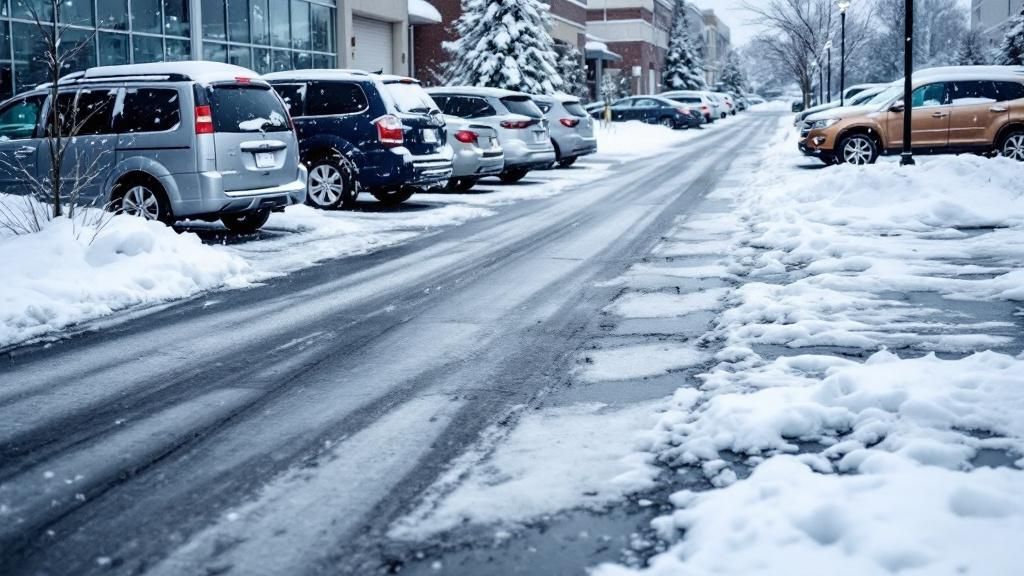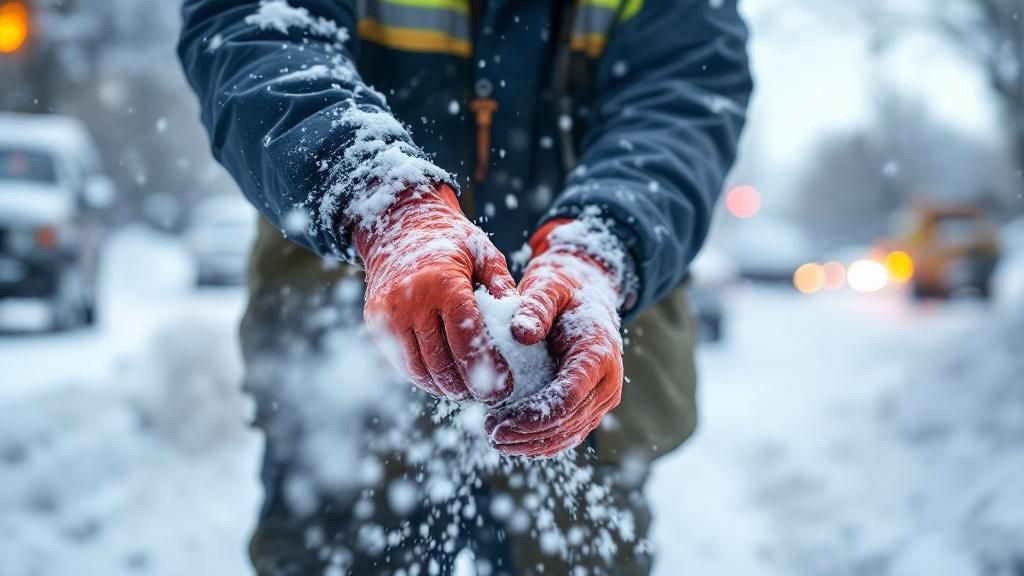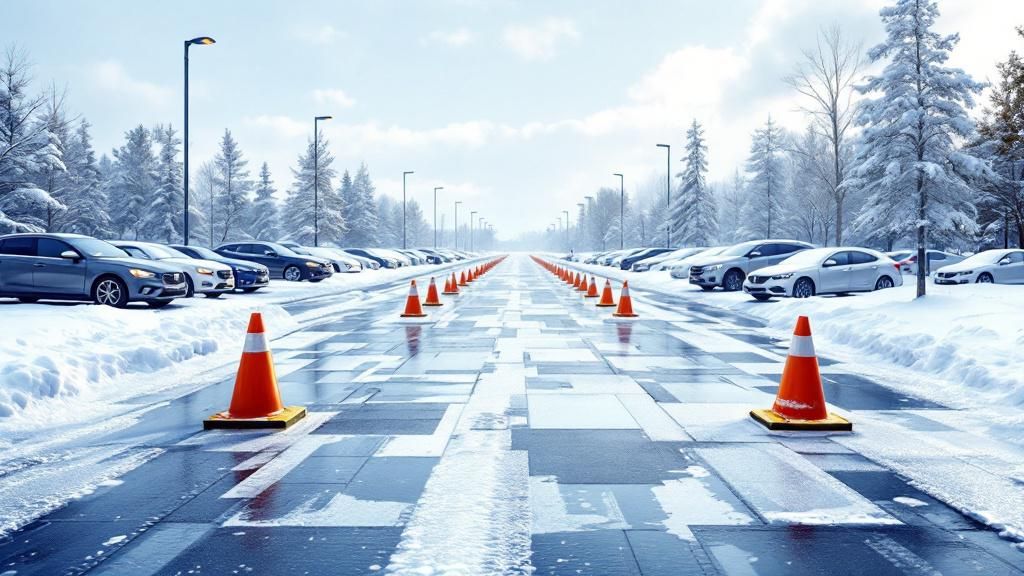
Snow and Ice Risks in Commercial Parking Spaces
Key Takeaways
-
Snow and ice are top contributors to winter hazards in commercial parking areas.
-
Effective plowing and ice control minimize accident risks and business liability.
-
Poor snow management can lead to expensive lawsuits and customer injuries.
-
Residential snow removal best practices can be adapted for commercial use.
-
Proactive planning ensures safer access, smoother traffic, and fewer incidents.
Alaska’s winters don’t just challenge roadways—they turn commercial parking lots into potential danger zones. Icy patches and snow accumulation make even short walks hazardous and raise the risk of vehicle collisions. For business owners and property managers, poor snow and ice management doesn’t just cost customer trust—it can lead to lawsuits. This guide highlights the science, stats, and best practices that help commercial lots stay safe and functional all winter long.
The True Cost of Winter Parking Lot Hazards
Parking lots blanketed in snow aren’t just inconvenient—they can be legally and financially risky. According to the U.S. Bureau of Labor Statistics, over 20,000 injuries happen annually due to icy surfaces. Most of these are preventable with the right strategy.
Hazards include:
-
Slippery surfaces leading to slip-and-fall accidents
-
Reduced visibility of parking lines, curbs, or signage
-
Snow piles blocking lanes or fire access
-
Frozen runoff creating black ice near entrances
Neglecting to address these issues can put businesses at risk of personal injury claims, employee accidents, and ADA compliance violations.
Parking Lot Obstacles: What Snow and Ice Hide
Snow and ice build-up can mask important structural and visual cues in a parking area. Covered curbs, potholes, and stop lines make navigation more difficult for drivers and dangerous for pedestrians.
As snowfall patterns become less predictable due to climate shifts, Alaskan businesses must prepare for more intense and frequent events. Forward-thinking operators are incorporating best practices from residential snow removal into their commercial strategies. These include:
-
Marking snow storage zones away from walkways
-
Upgrading lighting for improved visibility
-
Using signage to warn of ice-prone areas
These small shifts can dramatically improve safety while reducing cleanup time.
Rethinking Snow Management: Smarter, Not Just Harder
Old-school snow removal methods aren’t always enough. Today, commercial snow management is a strategic process that balances safety, efficiency, and cost.
Here are practices that can make a difference:
-
Anti-icing and pre-wetting: Apply treatments before snow falls to reduce ice bonding
-
Targeted de-icing: Focus salt and chemicals only where needed to minimize waste and runoff
-
Designated snow dump zones: Keep piles away from pedestrian paths and sight lines
-
Routine monitoring: Assign a team or vendor to check conditions hourly during storms
In Anchorage, where heavy snow is expected, managing logistics ahead of time is crucial. Knowing where your snow will go—and how quickly it’s cleared—can reduce downtime and customer complaints.

The Physics of Ice: Why Conditions Get So Risky
Managing snow and ice isn’t just about the weather—it’s about understanding how these elements behave. Ice melts at 0°C under normal pressure, but the presence of salt lowers this threshold, speeding up melt time. This is why salt is so effective—when used correctly.
But snow has insulating properties too. A light snow layer can actually trap ground warmth and slow the formation of ice, but once compacted or frozen, it contributes to slipperiness. Snow’s ability to hold moisture also complicates removal—wet, heavy snow puts more stress on your equipment and your timeline.
For property managers, understanding these basic principles helps improve how and when to apply different treatments, especially during back-to-back storms.
Behind the Scenes: How Snow Management Actually Works
A well-run snow operation includes more than a plow truck. It involves advance planning, team coordination, and equipment readiness. In cities like Anchorage, snow management vendors prepare before the first flake falls.
Key elements of efficient snow operations include:
-
Pre-season walk-throughs to identify problem zones
-
Dedicated snow managers who coordinate team movement
-
Heavy machinery staging for quick deployment
-
Clear SOPs for trigger depths and response times
Organizations like Facilities Services at SFU have refined this into a science with seasonal crews and layered response systems. In Alaska, where fast-changing weather is the norm, having an agile plan makes all the difference.
Local contractors like Titan offer scalable winter solutions for commercial properties, combining snow plowing, ice control, and on-call service to maintain safety without disrupting day-to-day business.
Preparing for the Next Winter: Don’t Wait Until It’s Too Late
The smartest businesses prep in fall, not after the first snowfall. A clear contract with your snow vendor, marked snow zones, and backup plans for refreezing events can set your property apart.
Here’s a winter prep checklist for commercial lots:
-
? Mark snow pile areas in advance
-
? Post ice warning signs at entrances and sidewalks
-
? Confirm your snow removal vendor’s response times
-
? Schedule mid-season site evaluations
-
? Keep spare salt and signage on hand
In regions like Anchorage, where snow and ice are expected realities, these proactive steps are critical.
FAQs
How does snow impact commercial parking lots?
Snow can obscure lines, block access points, and create slip hazards. It reduces efficiency and raises accident risks for drivers and pedestrians.
What liability issues are tied to icy parking lots?
Businesses may be held responsible for injuries or damage caused by neglecting proper snow and ice removal. This includes slip-and-fall accidents.
Is professional snow removal worth it for commercial properties?
Yes. Professionals have the equipment, training, and strategy to keep lots safe and compliant—saving you from costly claims and downtime.
What ice management practices work best?
Anti-icing before snowfall and de-icing after are a powerful combo. Use salt strategically and consider pre-wet treatments to boost performance.
How soon should you start preparing for winter?
Planning should begin in early fall, before the first snow arrives. This ensures contracts, supplies, and protocols are in place when they’re needed most.
